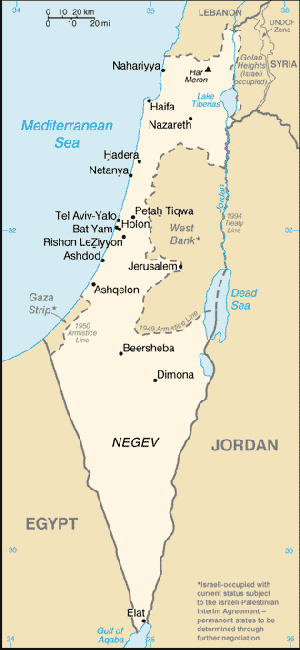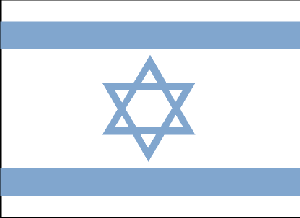
|

Israel
Background:
Following World War II, the British withdrew from their mandate of Palestine,
and the UN partitioned the area into Arab and Jewish states, an arrangement
rejected by the Arabs. Subsequently, the Israelis defeated the Arabs in a
series of wars without ending the deep tensions between the two sides. The
territories occupied by Israel since the 1967 war are not included in the
Israel country profile, unless otherwise noted.
Location:
Middle East, bordering the Mediterranean Sea, between Egypt and Lebanon.
Area: Total: 20,770 sq km, water: 440 sq km, land: 20,330 sq km.
Area - comparative: Slightly smaller than New Jersey.
Land boundaries: Total: 1,017 km, border countries: Egypt 266 km, Gaza Strip
51 km, Jordan 238 km, Lebanon 79 km, Syria 76 km, West Bank 307 km.
Coastline: 273 km.
Climate and Terrain:
Climate: Temperate; hot and dry in southern and eastern desert areas.
Terrain: Negev desert in the south; low coastal plain; central mountains;
Jordan Rift Valley.
Natural resources: Timber, potash, copper ore, natural gas, phosphate rock,
magnesium bromide, clays, sand.
People:
Population: 6,029,529.
Ethnic groups: Jewish 80.1% (Europe/America-born 32.1%, Israel-born 20.8%,
Africa-born 14.6%, Asia-born 12.6%), non-Jewish 19.9% (mostly Arab.
Religions: Jewish 80.1%, Muslim 14.6% (mostly Sunni Muslim), Christian 2.1%,
other 3.2%.
Languages: Hebrew (official), Arabic used officially for Arab minority, English
most commonly used foreign language.
Government:
Government type: Parliamentary democracy.
Capital: Jerusalem.
Independence: 14 May 1948 (from League of Nations mandate under British
administration).
Economy overview:
Israel has a technologically advanced market economy with substantial
government participation. It depends on imports of crude oil, grains, raw
materials, and military equipment. Despite limited natural resources, Israel
has intensively developed its agricultural and industrial sectors over the past
20 years. Israel is largely self-sufficient in food production except for
grains. Cut diamonds, high-technology equipment, and agricultural products
(fruits and vegetables) are the leading exports. I
GDP - composition by sector: Agriculture: 4%, industry: 37%, services: 59%.
Statistics:
Telephones - main lines in use: 2.8 million.
Telephones - mobile cellular: 2.5 million.
Radio broadcast stations: AM 23, FM 15, shortwave 2.
Radios: 3.07 million.
Television broadcast stations: 17 (plus 36 low-power repeaters).
Televisions: 1.69 million.
Internet users: 1.94 million.
Railways: total: 647 km.
Highways: Total: 15,965 km, paved: 15,965 km, unpaved: 0 km .
Airports: 54,
with paved runways: 29,
with unpaved runways: 25.
Heliports: 3.
Return to Visiting Locations
|

